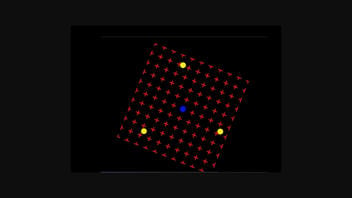
Will this test, which asks you to stare at a flashing blue dot to see if surrounding yellow dots disappear, tell you if you have attention-deficit/hyperactivity disorder, or ADHD? No, that's not true: Experts consulted by Lead Stories say ADHD cannot be diagnosed in the way this test describes. The diagnosis requires a licensed clinician and well-defined criteria.
The test appears in a video posted to Facebook on May 10, 2022. It involves a square grid, with a flashing blue dot in the middle and three yellow dots around it. A man in the video says:
Here's a test to see if you have ADHD. So you want to focus your eyes on that flashing dot in the middle of the screen and, as you stare at it, the surrounding yellow spots will gradually vanish from your consciousness one by one. But as soon as you let your eyes wander, the effect is broken and the dots will reappear. So, if you can only make one or two of the spots vanish, then I'd say you're easily distracted and find it difficult to hold your attention for long, and thus you might have ADHD.
This is what the post looked like on Facebook at the time of writing:
Lead Stories reached out to several ADHD experts to see if there is any truth to the online test. There's not.
Joshua M. Langberg, a licensed clinical psychologist and co-director of Virginia Commonwealth University's Center for ADHD Research, Education and Service, pointed Lead Stories to two websites, the Centers for Disease Control and Prevention (CDC) and the National Institute of Mental Health (NIMH). Both list strict diagnostic criteria for ADHD, including inattention and/or hyperactivity that interferes with a person's functioning or development. In an email dated June 17, 2022, Langberg wrote about the online test:
Not only is there no evidence for the task presented in being associated with ADHD, but it is clear the information is inaccurate because the task has nothing to do with the established diagnostic criteria for ADHD according to either the Diagnostic and Statistical Manual for Mental Disorders (DSM) or the World Health Organization's International Classification of Diseases and Related Health Problems (ICD).
Similarly, noted ADHD experts Maggie Sibley and Stephen V. Faraone dismissed the test as a viable way to diagnose the disorder. They both referenced the World Federation of ADHD International Consensus Statement, which says that ADHD can only be diagnosed by a licensed clinician who interviews the parent or caregiver and/or patient to document criteria for the disorder.
According to the statement, the main features of the diagnosis are:
1) the presence of developmentally inappropriate levels of hyperactive-impulsive and/or inattentive symptoms for at least 6 months; 2) symptoms occurring in different settings (e.g., home and school); 3) symptoms that cause impairments in living; 4) some of the symptoms and impairments first occurred in early to mid-childhood; and 4) no other disorder better explains the symptoms.















